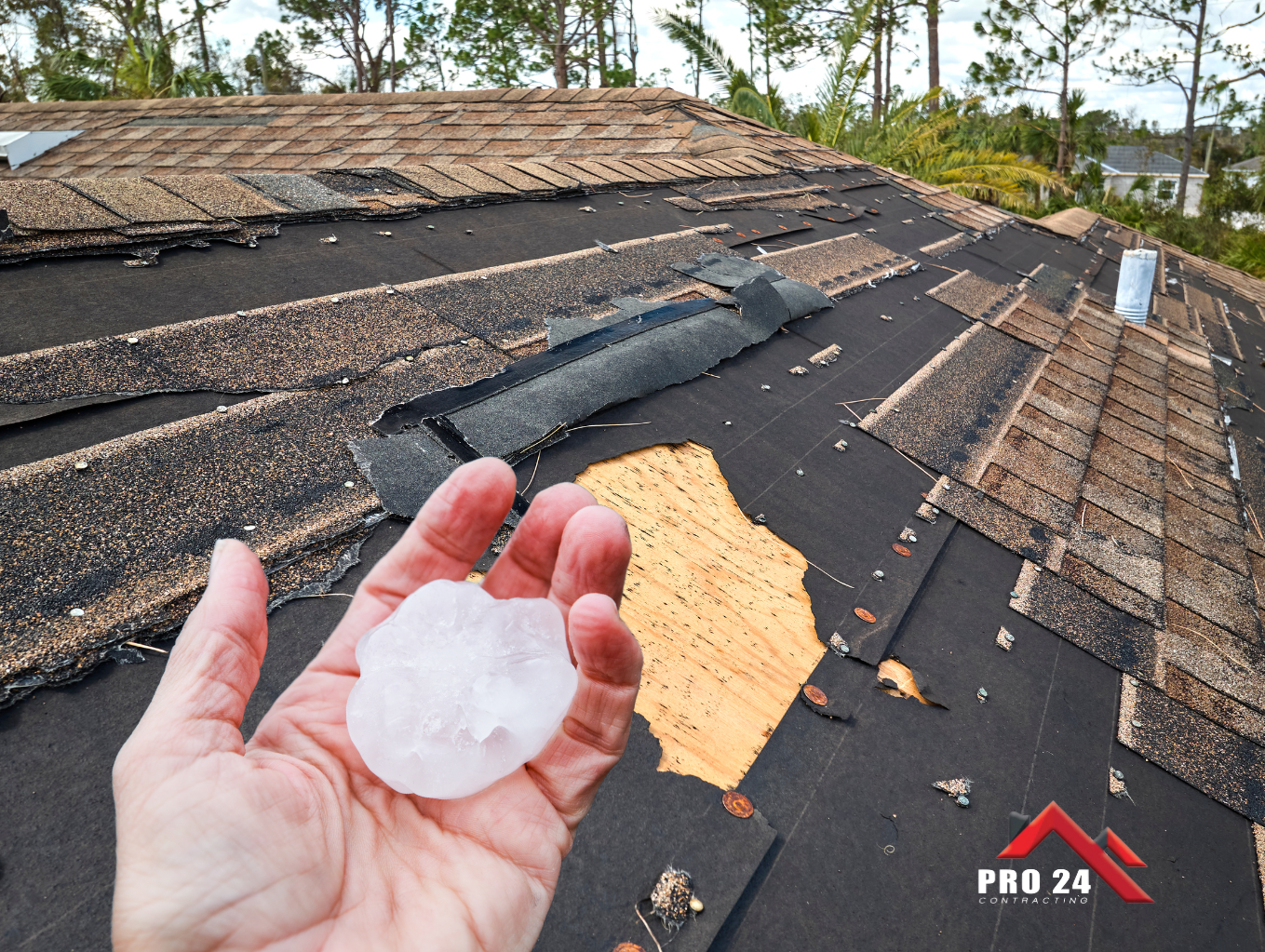Hailstorms, with their sudden and destructive nature, are a frequent hazard that can wreak havoc on properties. For homeowners, the roof often bears the brunt of the damage. While the immediate effects of hail are often obvious—dented metal, cracked shingles, or granule loss—the long-term consequences can remain hidden, silently compromising the integrity of your roof over time. Ignoring these issues doesn’t just endanger your roof; it can lead to costly repairs, reduced property value, and safety hazards.
Understanding the gradual deterioration caused by hail damage is critical for homeowners who want to protect their investments. In this article, we will delve into the hidden impacts of hail damage, explore how neglect can escalate repair costs, and highlight the importance of timely inspections and proactive maintenance. By taking preventive steps, you can extend the life of your roof and avoid unnecessary financial burdens.
Immediate vs. Long-Term Hail Damage
When hailstones strike, they often leave behind visible signs of damage such as dents, cracks, and granule loss. These issues might seem minor at first glance, but they can lead to significant problems if not addressed promptly. The long-term effects of hail damage are often more insidious and costly than the initial impact.
Immediate Effects
- Granule Loss. Hail can strip away the protective granules on asphalt shingles, leaving the underlying material vulnerable to damaging UV rays.
- Cracks and Bruises. Shingles, tiles, or membranes may crack or bruise upon impact.
- Dents. Metal roofs can suffer dents that compromise their appearance and functionality.
Long-Term Effects
- Water Infiltration. Small cracks or punctures can develop into leaks over time, leading to water damage inside your home.
- Structural Weakening. Repeated exposure to the elements can weaken your roof’s structural integrity.
- Energy Inefficiency. Damaged roofing materials may fail to provide adequate insulation, increasing energy bills.
Long-Term Effects of Untreated Hail Damage
1. Water Leaks and Damage
One of the most common and damaging long-term effects of hail damage is water infiltration. Even minor cracks or punctures caused by hail can allow moisture to seep into your roofing system. Over time, this moisture can:
- Promote Mold and Mildew Growth. Persistent dampness creates an ideal environment for mold and mildew, which can spread to other parts of your home and pose health risks.
- Damage Insulation. Wet insulation loses its effectiveness, leading to higher heating and cooling costs.
- Cause Ceiling Stains and Rot. Water leaks can result in unsightly stains on ceilings and walls, as well as wood rot in the structure.
2. Structural Weakening
Hail damage that is not repaired can compromise the structural integrity of your roof over time. For instance:
- Repeated Freeze-Thaw Cycles. Moisture trapped in cracks can expand and contract with temperature changes, enlarging the damage.
- Compromised Support Beam. Prolonged exposure to water can weaken wooden beams and supports, increasing the risk of collapse.
- Rust on Metal Components. Metal flashing and fasteners can corrode when exposed to moisture, further reducing the roof’s stability.
3. Reduced Energy Efficiency
A damaged roof can significantly impact your home’s energy efficiency. Missing granules, cracks, and other issues caused by hail reduce your roof’s ability to reflect sunlight and insulate your home. This can lead to:
- Higher Energy Bills. Increased reliance on heating and cooling systems to maintain indoor comfort.
- Uneven Indoor Temperatures. Drafts and hot or cold spots in your home due to poor insulation.
4. Decreased Curb Appeal and Property Value
Visible hail damage, such as dents or missing shingles, can detract from your home’s appearance. Over time, this can:
- Lower Resale Value. Potential buyers may see visible roof damage as a red flag, reducing the property’s marketability.
- Increase Maintenance Costs. Buyers may negotiate lower prices due to anticipated repair expenses.
5. Escalating Repair Costs
Neglecting hail damage often leads to more extensive and expensive repairs down the line. For example:
- Small Cracks Become Major Leaks. A minor issue left untreated can develop into widespread water damage, requiring costly repairs.
- Replacement Over Repair. Severe, unchecked damage may necessitate a full roof replacement rather than a simple patch or repair.
The Cost of Neglecting Hail Damage
Neglecting hail damage isn’t just a risk to your home’s structural integrity—it’s a direct threat to your financial stability. The costs of ignoring damage can compound quickly:
- Higher Repair Bills. Small, inexpensive fixes can escalate into large-scale repairs or even a full roof replacement when damage goes unchecked. For example, untreated leaks can lead to significant water damage in the attic and interior.
- Compromised Insurance Coverage. Insurance policies often require homeowners to report and address hail damage promptly. Failing to act could result in denied claims, leaving you with the full financial burden of repairs.
- Increased Insurance Premiums. Repeated claims for extensive damage can lead to higher premiums or policy cancellations.
- Secondary Damage Costs. Water infiltration can damage insulation, walls, ceilings, and electrical systems, resulting in thousands of dollars in secondary repair costs.
- Emergency Repairs. Neglected hail damage often leads to sudden, emergency repairs during severe weather, which can be more expensive due to the urgency and off-hours labor costs.
- Reduced Property Value. A damaged roof is a major red flag for potential buyers, who may request significant price reductions or avoid the property altogether.
The Importance of Proactive Maintenance
Proactive maintenance is the cornerstone of protecting your roof and your investment from the long-term effects of hail damage. Here’s why it’s essential:
1. Preserve Roof Longevity
Regular inspections and timely repairs can extend your roof’s lifespan. By addressing minor issues before they escalate, you avoid premature roof replacements and ensure your home remains protected against the elements.
2. Prevent Escalating Costs
Taking swift action after a hailstorm prevents minor damage from worsening. Repairing a small crack or leak is far less costly than addressing widespread water damage, structural weakening, or mold remediation down the line.
3. Maintain Energy Efficiency
A well-maintained roof provides optimal insulation, keeping your home comfortable and your energy bills in check. Proactive maintenance ensures that damaged or worn-out materials are replaced before they compromise your home’s energy efficiency.
4. Protect Your Home’s Value
A roof in excellent condition boosts your property’s curb appeal and market value. It also reassures potential buyers that your home has been well cared for, making it easier to sell at a competitive price.
5. Ensure Safety
Damaged roofs can pose safety risks, including the potential for collapse during severe weather. Regular inspections and repairs safeguard your family and property from these dangers.
6. Simplify Insurance Claims
Proactive maintenance includes documenting your roof’s condition through inspections and repair records. This documentation makes it easier to file insurance claims and ensures you receive the compensation needed to address hail damage.
Steps to Prevent Long-Term Hail Damage
- Schedule Regular Inspections. Arrange for annual professional roof inspections or after major storms. Professional inspections can identify hidden damage and ensure that small issues are addressed before they escalate.
- Address Damage Promptly. Don’t delay necessary repairs. Even minor damages like cracks or dents can lead to serious issues over time, such as water infiltration or structural weakening.
- Invest in High-Quality Materials. Consider replacing older materials with impact-resistant roofing materials. Options like Class 4 shingles or metal roofs are designed to withstand hailstorms and offer long-term durability.
- Upgrade Your Gutters and Downspouts. Ensure your gutters are well-maintained and capable of efficiently draining water away from your home. Poor drainage can exacerbate existing damage and lead to water pooling.
- Trim Overhanging Branches. Remove any branches that hang over your roof. During hailstorms, branches can break off and cause additional damage to your roof.
- Install Protective Features. Consider adding hail guards, reinforced flashing, or impact-resistant skylights to further protect your roof from hail damage. These features can help absorb and deflect impact forces.
- Monitor Your Attic for Signs of Damage. Regularly check your attic for signs of water leaks, such as damp insulation or water stains. Early detection can prevent extensive damage.
- Document All Maintenance and Repairs. Keep detailed records of inspections, repairs, and upgrades. This documentation can support insurance claims and demonstrate the care you’ve invested in your roof.
Conclusion
Hail damage may appear superficial at first, but the long-term consequences of neglect can be severe. From water leaks and structural weakening to reduced energy efficiency and escalating repair costs, untreated hail damage poses significant risks to your home and finances. Taking proactive measures not only protects your roof but also safeguards your peace of mind.
By scheduling regular inspections, addressing issues promptly, and investing in high-quality materials, you can mitigate the risks associated with hail damage. These efforts also maintain your home’s energy efficiency, curb appeal, and overall market value. Proactive maintenance ensures your roof remains resilient against future storms, giving you confidence in your property’s ability to weather any challenge.
At Pro 24 Roofing, we specialize in comprehensive inspections, expert repairs, and tailored solutions to address hail damage. Our dedicated team is committed to providing top-tier service that prioritizes your home’s longevity and safety. Don’t wait until small issues become costly problems. Contact Pro 24 Roofing today to schedule an inspection and protect your investment for years to come.

